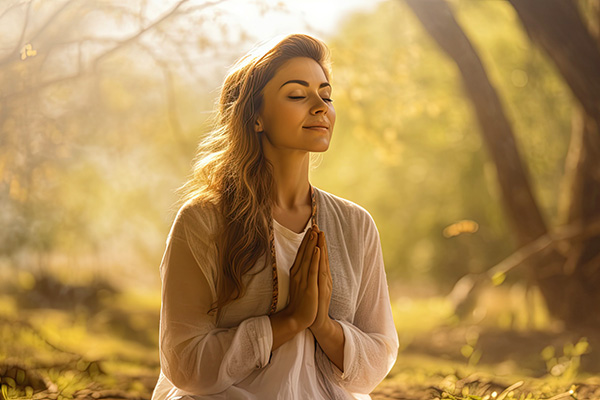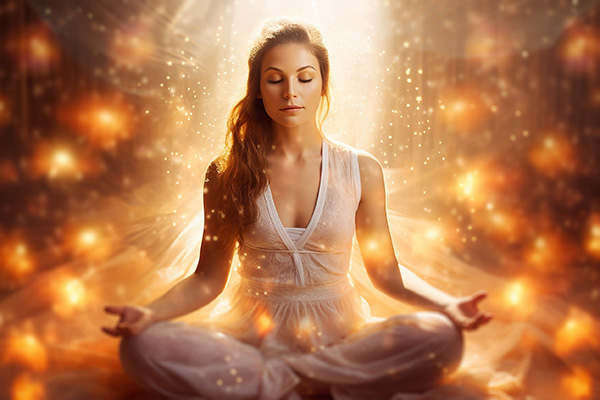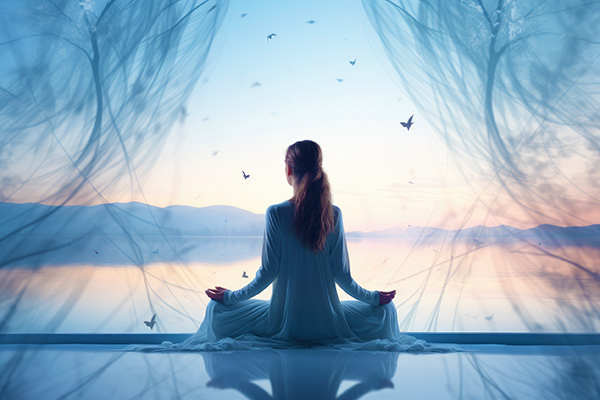inner being
Replace Nighttime Overthinking With Morning Clarity
 As night falls and the world quiets down, our minds often do the opposite. Many of us find ourselves caught in a relentless tide of overthinking as we replay the past and stress about the future. This mental whirlwind of worry can leave us feeling mentally foggy and emotionally drained, far from our true selves.
As night falls and the world quiets down, our minds often do the opposite. Many of us find ourselves caught in a relentless tide of overthinking as we replay the past and stress about the future. This mental whirlwind of worry can leave us feeling mentally foggy and emotionally drained, far from our true selves.
But within all this turmoil lies a powerful opportunity for personal growth and empowerment. How is this possible? Well, the key to ending the constant spiral and realigning ourselves with our highest good lies in cultivating greater intuitive awareness and mental clarity.
Overthinking at night is a common problem for many of us. In the silence of the night, after being on autopilot all day, our overactive minds become a breeding ground for worry, fear, and regret. Over time, this leads to a vicious cycle of anxiety and insomnia, which leads to more stress the next day, which leads to more anxiety and insomnia the next night, and so on.
The results are not only that we feel constantly tired and energetically drained, but we also lose our sense of self and connection to our soul purpose. Feeling energetically drained and disconnected from our authentic selves, we begin to question our choices and direction in life, leading to increased anxiety and decreased self-esteem. It becomes a very toxic spiral that is devastating to our physical, mental, emotional and spiritual well-being!
Finding Your Silent Space Within
 Finding our silent space within is the essential spiritual practice. Cultivating a sense of inner stillness, mindfulness, and presence is crucial to any spiritual, metaphysical, or esoteric practice, as it allows for a deeper connection to your higher self, the universe, and the divine.
Finding our silent space within is the essential spiritual practice. Cultivating a sense of inner stillness, mindfulness, and presence is crucial to any spiritual, metaphysical, or esoteric practice, as it allows for a deeper connection to your higher self, the universe, and the divine.
The silent space within is the inner connection point to our spirit or soul — the part of our being that is eternal and transcendent. This relationship is fundamental to most spiritual, religious, and esoteric traditions, which often describe the silent space within as a portal or bridge to a deeper understanding and connection with the soul, the divine, or the universal consciousness.
In many traditions, cultivating the silent space within is considered essential to achieving enlightenment or spiritual liberation — the realization of one’s true nature as soul or spirit, beyond physical and mental limitations. This realization of inner silence is our awakening to the eternal aspect of our being.
A concept used in various spiritual, meditative, and mindfulness practices, the notion of a silent space within symbolizes the inner sanctuary where one can retreat to find inner peace and strength, clarity, and a sense of centeredness, regardless of external circumstances. It is where we feel a deeper connection to something greater than ourselves, which is central to any spiritual path.
Reclaim Your Personal Power With ‘Sat Nam’
 As a Kundalini Yoga teacher, I had the unique privilege of studying with Yogi Bhajan, the yoga master who introduced Kundalini Yoga to the Western world. Before he passed away in 2004, Yogi Bhajan gave me my spiritual name, Satya Kaur, which essentially means “princess” or “lioness” who embodies or strives to live by the principle of truth. It symbolizes a spiritual identity or path that focuses on integrity, authenticity, and the pursuit of spiritual truth.
As a Kundalini Yoga teacher, I had the unique privilege of studying with Yogi Bhajan, the yoga master who introduced Kundalini Yoga to the Western world. Before he passed away in 2004, Yogi Bhajan gave me my spiritual name, Satya Kaur, which essentially means “princess” or “lioness” who embodies or strives to live by the principle of truth. It symbolizes a spiritual identity or path that focuses on integrity, authenticity, and the pursuit of spiritual truth.
Our soul identity is the key to our life journey and spiritual growth. For this reason, at the end of each Kundalini Yoga class, the teacher says “Sat Nam” to the students. The class then repeats these words back to the teacher. Because of the name Yogi Bhajan gave me, this mantra will always have a special place in my heart.
The phrase is a Gurmukhi term that translates to “Truth is my name” or “True identity.” It is used as a yoga mantra to center the mind, connect with one’s true self, and remind us of our true essence and reality beyond the physical and mental constructs of the external world.
Saying “Sat Nam” to others is similar to the greeting “Namaste,” which means “The divine in me bows to the divine in you,” or “The spirit in me salutes the spirit in you.” For me, sacred affirmations like “Sat Nam” and “Namaste” have even more power and meaning now in the dawning Age of Aquarius.
The Ancient Wisdom Of The Two Wolves
 The story of the Two Wolves holds a special place among my childhood favorites. The moral of this Native American wisdom tale, thought to have originated with the Cherokee tribe, serves as a daily guiding light in my life.
The story of the Two Wolves holds a special place among my childhood favorites. The moral of this Native American wisdom tale, thought to have originated with the Cherokee tribe, serves as a daily guiding light in my life.
I must confess, there is some sentimental bias on my part, as this story also brings back lovely memories of my remarkable grandfather, Sequoia, a former medicine man and chief of the Cherokee Nation.
Variations of the story exist in various Native American cultures, and it typically goes like this:
One evening, an old Cherokee is teaching his granddaughter about life and says, “My daughter, a fight is going on inside all of us each day. It is the battle between the two wolves.”
“One wolf is evil — anger, envy, jealousy, sorrow, regret, greed, arrogance, self-pity, guilt, resentment, inferiority, lies, false pride, superiority, and ego. The other wolf is good — joy, peace, love, hope, serenity, humility, kindness, benevolence, empathy, generosity, truth, compassion, and faith.”
The granddaughter thinks about it for a minute and then asks her grandfather, “Which wolf will win?”
Harnessing Intuition To Be A Better Manager
 In the demanding landscape of modern business, effective leadership is more important than ever. As a leader, navigating the complexities of the workplace requires a unique set of skills, and while data-driven decision-making and strategic planning are undoubtedly important, there are powerful tools that are often overlooked: intuition and spirituality.
In the demanding landscape of modern business, effective leadership is more important than ever. As a leader, navigating the complexities of the workplace requires a unique set of skills, and while data-driven decision-making and strategic planning are undoubtedly important, there are powerful tools that are often overlooked: intuition and spirituality.
Inner wisdom and spiritual awareness are invaluable assets for managers seeking to improve their leadership skills. By cultivating a deeper connection with our inner being and the universe, we gain access to a source of wisdom and guidance. It enables one to tap into a deeper understanding and a higher level of consciousness that gives you a winning edge of increased empathy and nuanced awareness in the workplace.
True intuition is more than guesswork or simply a culmination of our past experiences, knowledge, and insights. It is a mystical force, a spiritual superpower, a key component of our inner guidance system.
As a leader, you’ve probably faced countless challenges and solved numerous problems throughout your career. Intuition allows you to tap into the inner guidance of your higher self to make better decisions and more accurate judgments.
The Four Dimensions Of Holistic Self-Care
 In today’s fast-paced world, we get caught up in the hustle and bustle of everyday life, leaving little time for self-care. Yet, holistic self-care is essential for a healthy, happy, and fulfilling life.
In today’s fast-paced world, we get caught up in the hustle and bustle of everyday life, leaving little time for self-care. Yet, holistic self-care is essential for a healthy, happy, and fulfilling life.
There are also various myths about self-care. For example, self-care is not a one-size-fits-all approach. It is also sometimes misunderstood to simply mean ‘spa days’ or ‘bubble baths with candles.’
True self-care is multidimensional and includes various activities and practices that promote physical, emotional, mental, and spiritual health and well-being. Self-care is the ultimate expression of self-love.
It is important to adopt self-care practices that work for you and that suit your lifestyle. There is no right or wrong way to practice spiritual self-care.
The most important thing is to find activities that also help you to connect with your inner being and that nourishes your spirit, because for many people today, spirituality is often the most important missing piece of their self-care puzzle.
When spirituality is incorporated into our daily self-care routine it has a profound impact on our overall health and well-being. Spiritual self-care helps us to develop a deeper understanding of ourselves and our place in the world, and empowers us with the resilience to better cope with stress and adversity. In order to live a fulfilling and balanced life, it’s essential to embrace self-care in all its dimensions, including our spiritual health.
Empower Yourself With Mindfulness
 Is your inner guidance system out of sync? Do you feel out of alignment with your higher self? Out of touch with the universal flow? Disconnected from Spirit? You are not alone.
Is your inner guidance system out of sync? Do you feel out of alignment with your higher self? Out of touch with the universal flow? Disconnected from Spirit? You are not alone.
In today’s fast-paced, hyper-connected world, where digital information is exchanged at an unprecedented rate, finding a moment of stillness and spiritual connection can feel like chasing a mirage in the desert.
Our modern lives are characterized by a relentless barrage of demands on our time and attention, both personally and professionally, and a constant stream of distractions from every conceivable angle.
The cacophony of app alerts, text messages, emails, social media updates, and the pressure to stay “in the loop” can be overwhelming. Yet we remain perpetually tethered to our screens, constantly on edge and spiritually disconnected.
Being constantly busy has become a toxic badge of honor in our society. Being on the go and constantly multitasking has become associated with success and prosperity. But this obsession with busyness is a poisoned chalice. Yes, we may get more done, but in the long run it comes at a great cost to our mental and physical health, as well as our spiritual well-being.